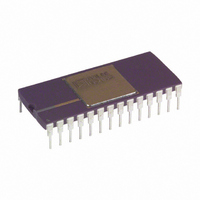AD569BD Analog Devices Inc, AD569BD Datasheet

AD569BD
Specifications of AD569BD
Available stocks
Related parts for AD569BD
AD569BD Summary of contents
Page 1
FEATURES Guaranteed 16-Bit Monotonicity Monolithic BiMOS II Construction 0.01% Typical Nonlinearity 8- and 16-Bit Bus Compatibility 3 s Settling to 16 Bits Low Drift Low Power Low Noise APPLICATIONS Robotics Closed-Loop Positioning High-Resolution ADCs Microprocessor-Based Process Control MIL-STD-883 Compliant ...
Page 2
AD569–SPECIFICATIONS Model AD569JN/JP/AD Parameter Min RESOLUTION LOGIC INPUTS V (Logic “l”) 2 (Logic “0” 5 TRANSFER FUNCTION CHARACTERISTICS Integral Nonlinearity ...
Page 3
AC PERFORMANCE CHARACTERISTICS These characteristics are included for Design Guidance Only and are not subject to test +12 V; –V = – – REF Parameter Limit Output Voltage Settling 5 (Time ...
Page 4
... AD569JP 0.04% AD569KN 0.024% AD569KP 0.024% AD569AD 0.04% AD569BD 0.024% AD569SD 0.04% NOTES 1 For details on grade and package offerings screened in accordance with MIL-STD-883, refer to the Analog Devices Military Products Databook or current AD569/883B data sheet Ceramic DIP Plastic DIP Plastic Leaded Chip Carrier. ...
Page 5
FUNCTIONAL DESCRIPTION The AD569 consists of two resistor strings, each of which is di- vided into 256 equal segments (see Figure 3). The 8 MSBs of the digital input word select one of the 256 segments on the first string. ...
Page 6
AD569 Figure 5. Typical DNL at Segment Boundary Transitions a. Segment 1 b. Segment 256 Figure 6. Typical DNL Within Segments MULTIPLYING FEEDTHROUGH ERROR: This is the error due to capacitive feedthrough from the reference to the output with the ...
Page 7
Zener diode fail (a short circuit would be the most likely failure), the supply voltage decreases. This differs from the situation where the diode is used as a series regulator. In that case, a failure ...
Page 8
AD569 Figure 9. MSB Resistor Divider Figures 11, 12, and 13 show reference configurations for various output ranges. As shown in Figure 11, the pin-programmable AD588 can be connected to provides tracking 5 V outputs with 1-3ppm/ C temperature stability. ...
Page 9
MULTIPLYING PERFORMANCE Figure 14 illustrates the gain and phase characteristics of the AD569 when operated in the multiplying mode. Full-power bandwidth is shown in Figure 14a and the corresponding phase shift is shown in Figure 14b. Performance is plotted for ...
Page 10
AD569 under worst-case conditions (hex input code 0000), feedthrough remains below –100 reference frequencies kHz. Figure 16. Multiplying Feedthrough BYPASSING AND GROUNDING RULES It is generally considered good engineering practice to use bypass capacitors ...
Page 11
Simple Interface b. Fast Interface Figure 20. 8-Bit Microprocessor Interface 8-Bit Microprocessor Interfaces Since 8-bit microprocessors require two write cycles to provide the AD569’s 16-bit input, the DAC register must be utilized most often loaded as the ...
Page 12
AD569 Preceding the second flash, the residue signal must be amplified by a factor of 256. The OP37 provides a gain of 25.6 and the AD630 provides another gain of 10. In this case, the AD630 acts as a gain ...













